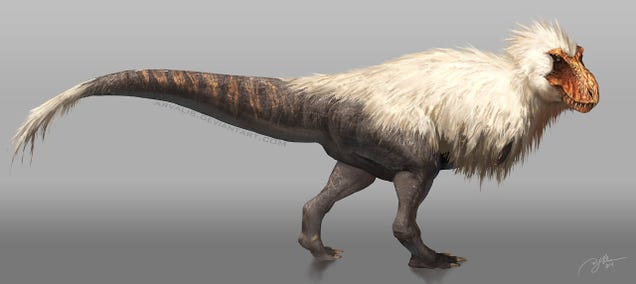Mermandala
Member
Feathered T.REX

(shown here with guitar)

(shown here with guitar)

Utahraptor right? Not velociraptor, which wasn't badass at all.Except raptors and T-rexes, the two most people consider to be the most bad-ass.
Just googled feather t-rex and I'm now highly disturbed

Came for this again.Gonna post what I posted on another forum about this
-The authors do not contest the presence of feathers in Theropoda (JP terms: t-rex/raptors/gallimimus/etc)
-The authors contest the presence of true feathers or protofeathers in Ornithischia (stegosaur/ankylosaur/iguanodon/'ceratops) but do not contest that Orniths have developed other filamentous structures (as in Psittacosaurus or Tianyulong, ceratopsians for which we have skin impressions demonstrating these structures) - they're just saying these structures did not turn into the feathers of modern day birds
-They used pterosaurs as an outgroup. Pterosaurs aren't particularly scaly, and their own filamentous structures (pycnofiber hairs) probably developed independently of dinosaur feathering or other integumentary structures, as in the reason they developed those structures might have been completely different (related to their surface area issues and of course flight!)
-The paper mainly wanted to push forward the revolutionary idea that the ancestral dinosaur species were scaly, not feathered or featuring other special integument accessories
-Sedimentology has a strong effect on what is preserved, and many integument specimens cannot even be found (many complete fossils, as in just the BONES, cannot be found). This paper is a caution against overinterpretation (ex. when psittacosaurus was found, some people started going "well maybe they are all fuzzy")
-If you are curious about the sauropod group: there are some preserved embryos of one species with scaly skin
-This write-up of the paper assumes a LOT more than what the paper actually says, even from the first sentence.
Here's a listserv conversation about this work (pre-publication so not all data available) from way back in December 2013: http://dml.cmnh.org/2013Dec/msg00187.html
Here is the present conversation about the finished paper (but it doesn't say much yet): http://dml.cmnh.org/2015Jun/msg00015.html
PS

Yay! Death to Chicken-Rex!
Don't mess with people's childhoods man.The super strong contentions on both sides of "feathers and dinosaurs" is fascinating to me. The hostility, the passion, the vitriol...truly fascinating that so many care that much.
No one outside of super speculative artists thought they were all feathered. This is nothing new.
Cassowary, meng. They're terrifying.You cannot stare at the eyes of an ostrich And not see the bloodlust of a velociraptor. I call shenanigans science!
Cassowary, meng. They're terrifying.
I still can't believe someone can look at a 40 foot long 7 ton carnivore with a mouth full of teeth the size of bananas and say "it's not cool because it's probably fluffy".So basically, dinosaurs aren't cool anymore. Thanks science.
So basically, dinosaurs aren't cool anymore. Thanks science.
I still can't believe someone can look at a 40 foot long 7 ton carnivore with a mouth full of teeth the size of bananas and say "it's not cool because it's probably fluffy".
Gonna post what I posted on another forum about this
-The authors do not contest the presence of feathers in Theropoda (JP terms: t-rex/raptors/gallimimus/etc)
-The authors contest the presence of true feathers or protofeathers in Ornithischia (stegosaur/ankylosaur/iguanodon/'ceratops) but do not contest that Orniths have developed other filamentous structures (as in Psittacosaurus or Tianyulong, ceratopsians for which we have skin impressions demonstrating these structures) - they're just saying these structures did not turn into the feathers of modern day birds
-They used pterosaurs as an outgroup. Pterosaurs aren't particularly scaly, and their own filamentous structures (pycnofiber hairs) probably developed independently of dinosaur feathering or other integumentary structures, as in the reason they developed those structures might have been completely different (related to their surface area issues and of course flight!)
-The paper mainly wanted to push forward the revolutionary idea that the ancestral dinosaur species were scaly, not feathered or featuring other special integument accessories
-Sedimentology has a strong effect on what is preserved, and many integument specimens cannot even be found (many complete fossils, as in just the BONES, cannot be found). This paper is a caution against overinterpretation (ex. when psittacosaurus was found, some people started going "well maybe they are all fuzzy")
-If you are curious about the sauropod group: there are some preserved embryos of one species with scaly skin
-This write-up of the paper assumes a LOT more than what the paper actually says, even from the first sentence.
Here's a listserv conversation about this work (pre-publication so not all data available) from way back in December 2013: http://dml.cmnh.org/2013Dec/msg00187.html
Here is the present conversation about the finished paper (but it doesn't say much yet): http://dml.cmnh.org/2015Jun/msg00015.html
PS

